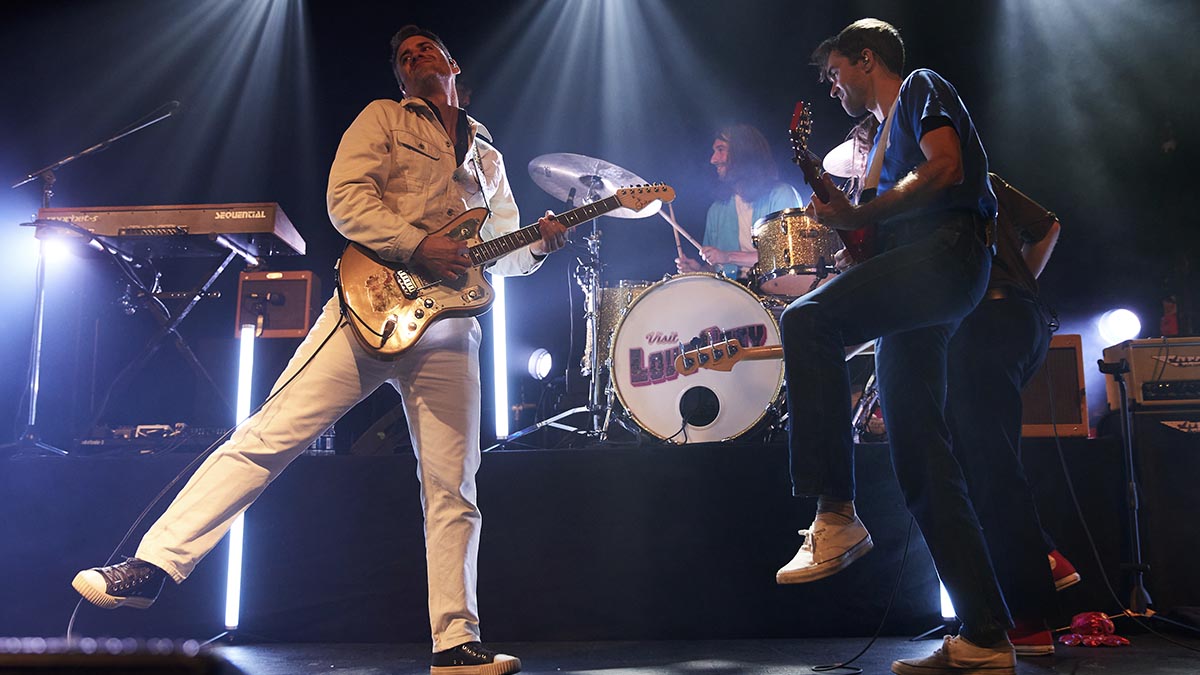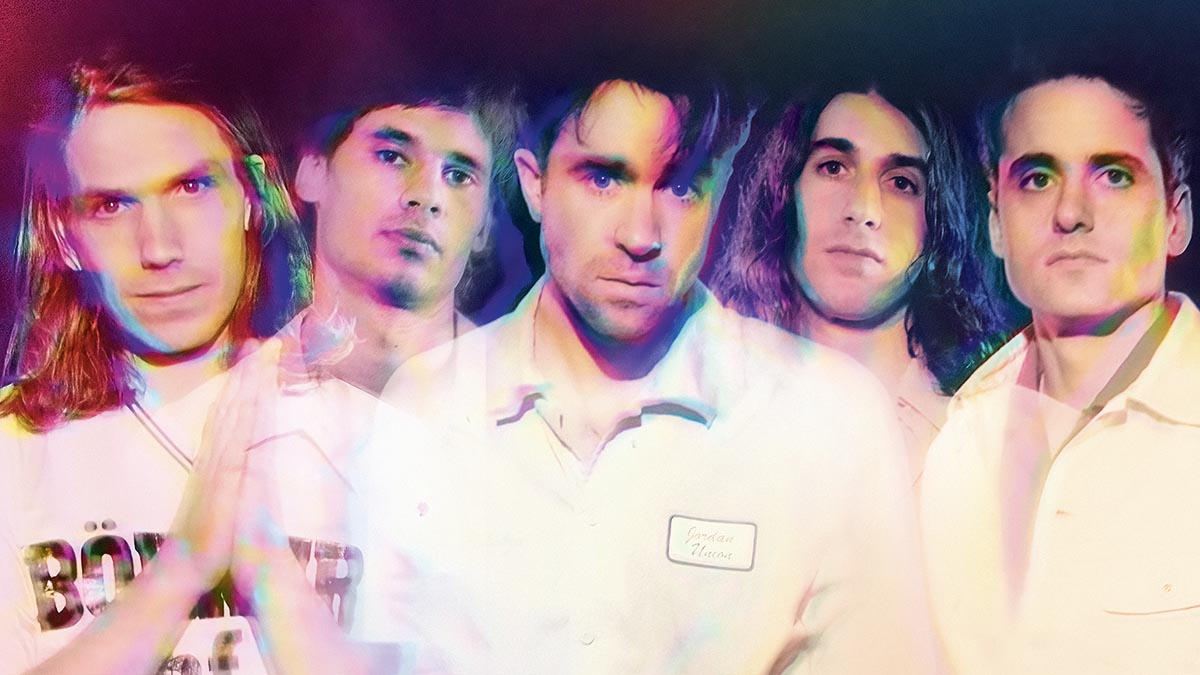The Vaccines’ Freddie Cowan and Justin Young on the tones and Tex-Mex inspirations behind Back In Love City
Recorded at Sonic Ranch, El Paso, Back In Love City finds the Vaccines reference classic rockabilly tones, Morricone, and the irresistible energy of Mexico City

The Vaccines frontman Justin Young puts it simply. “In some ways this is our most rock record.” He’s talking about Back In Love City, a high-tech set of songs that fuse futuristic keyboards and loops with retro rockabilly twang and punk rock powerchords.
It was produced by Daniel Ledinsky, better known for collaborations with Tove Lo and Rihanna. But this is a guitar-driven album, shaped by Justin and the band’s lead player Freddie Cowan.
“Eight or nine songs were built around lead guitar riffs,” Justin says. “Freddie was just sending me great riffs that inspired me to write over them.” The result is what Justin calls “a weird paradox of being more rock but also more pop”. And as Freddie explains, he had an unexpected source of inspiration for these riffs...
“My soon-to-be wife and I lived in Mexico City for a couple of months in 2019,” he says. “In Centro Histórico, the old centre, each street sells a different thing. We just happened to rent an apartment on the street that sold musical instruments. Immediately it’s a really intense place to be living. We did a gig in Juarez. It’s kind of a Tarantino, Mexico-meets-Texas, rattlesnakey vibe.
“Retrospectively you can say it’s a bit like Brian Setzer and it’s a bit Morricone. The geography, the energy, the whole thing was just really inspiring. I’m still wearing a mariachi shirt, still so absorbed by that whole culture. I’m having this obsession with the great Mexican singers like Juan Gabriel.”
The resulting cinematic compositions were recorded at Sonic Ranch, the world’s biggest residential studio complex in El Paso, Texas. It’s a charmingly old-school way of working in a world of number one albums produced in bedrooms.
“It’s one of those pipe dreams you have when you’re learning your favourite songs on guitar and thinking about what it might look like if you were lucky enough to do it for living,” Justin says. “I think we all felt blessed to be in this insular environment where we didn’t leave the studio for weeks on end, and all we were doing was waking up, eating, making music...”
Get The Pick Newsletter
All the latest guitar news, interviews, lessons, reviews, deals and more, direct to your inbox!
“You could walk from the studio to the border wall that separates Mexico and the US,” says Freddie. “They had border patrol vans driving around. It was a serious vibe. The studio owner would come in with 10 guns strapped to him, like ‘Who wants to shoot? This is the gun that won the West!’”
Freddie’s guitar tone resulted from a happy accident. “EarthQuaker Devices pedals are often good at doing things that they’re not ‘supposed’ to do,” he says. “I got The Organizer, which is supposed to make an organ sound. I don’t know how I stumbled across it, but I used it to make the guitar sound like a baritone.
“You have the sub octave up a tiny bit, use the tone to boost it a little bit, and boost the level so it acts like a compressor. It has this little sub-octave on it and it makes things sound like Link Wray or Bo Diddley. You’re like, ‘Fuck, that sounds like an old record!’ I use it on everything now.”

He also passes on a tip from a rockabilly legend. “I was talking to the guys at Gretsch about Brian Setzer. He uses a [vintage Roland] Space Echo which gives the compression at the front end, gives it that ping. Now I send everything through the Space Echo whether there’s slapback on it or not, just to get the EQ.”
The amp sounds on Back In Love City come courtesy of three Sonic Ranch house amps: a 60-watt Komet head into an old Vox Greenback cab for cleans, a 15-watt Divided By 13 amp for dirty, and a vintage Fender Champ for filth, all with his two always-on pedals, the EarthQuaker Organizer and a Z.Vex Super Duper 2-in-1 boost. Reverb and modulation come from an Eventide H9. And then there is the band’s secret weapon...
“Our bass player, Árni [Árnason] made me this pedal for my birthday,” Freddie says. “I thought, ‘It’s probably rubbish,’ but I used it out of politeness, and it was the coolest-sounding pedal. I call it the Bumble Beast because it sounds like a bee in a can, but it’s super-powerful. It’s vintage but also quite unique and contemporary. That really saved the day because it’s quite difficult to do a fuzz sound you haven’t really heard before.”
Although he’s an obvious guitar nerd, Freddie is philosophical about the dangers of disappearing up one’s own posterior in pursuit of tone. This is something he’s been thinking about since the making of the band’s 2018 album Combat Sports, when he had a memorable exchange with producer Ross Orton, whose clients also include Arctic Monkeys.
“Ross got so impatient with me because every song I was like, ‘I wonder what sound we should use?’ He was like, ‘For fuck’s sake, it’s just a guitar! What are you doing?’ By the end of that record I thought maybe he’s right. Why should it take two hours every time you want to find a sound? So this time I only took one guitar. I found a luthier, John Shuker, who works in the Peak District and he’s a genius.
I retain no information about gear whatsoever. After 10 years I’m still a complete luddite and beginner
Justin Young
“We designed a guitar together, and since then I’ve sold all my vintage guitars. We took a Jaguar-shaped body and he made the body in layers so it’s chambered but it doesn’t have f-holes. It’s got a P-90 in it and a Brian May Tri-Sonic in the neck, and an active mid booster.”
Working in El Paso meant the band also got their hands on some legendary Texas gear. Keyboardist Timothy Lanham tracked additional guitars through a Fender Tweed that used to belong to ZZ Top, while Freddie made use of a prestigious backup guitar.
As he explains: “I used an old Fender Esquire that used to belong to Stevie Ray Vaughan to do some double tracking. A lot of the baritone stuff is the Shuker guitar doubled with the Esquire, which has this really sharp sound.”
Not to be outdone in the celebrity guitar stakes, Justin has his own story: “I spent some time in LA, and Daniel Lavinsky owns one of Elliot Smith’s old nylon-string guitars. El Paso was written on that.
“I’ve been lucky enough to play a few guitars that have you know been owned by players far superior to me. You feel like it brings you closer to that greatness. You realise that actually there’s nothing standing in between you and that greatness other than yourself. For me, it’s always been less daunting and more inspiring.”
Justin is less forthcoming, however, about the rest of his rig. “I did warn our press people before the interview,” he laughs. “I retain no information about gear whatsoever. Freddie is a proper gear head. After 10 years I’m still a complete luddite and beginner.”
Justin thinks this indifference to his gear has freed him up to focus on the creative side, though. And it’s not just equipment: he has a similarly haphazard approach to music theory.
“I don’t know any scales. I know a few chords. Sometimes I’ll be writing and I’ll happen across something. I’m like, ‘Nothing too discordant in there, sounds like a chord to me!’ I’ll frequently write entire songs and won’t know what any of the chords are that I’ve used!”
“I’m not a great player,” he admits. “But in some ways that’s been really helpful. Every time I pick up guitar I feel like I’m picking it up for the first time again. I’m left-handed as well, and play right-handed. I always struggle my way through. Every record there’ll be a couple of lead parts I’ve written and given to Freddie. Once I’ve committed them to tape, I’ve completely forgotten how I ever played them.”
But his lack of interest in technical details does not equate to a lack of passion for the instrument. He ends the interview by enthusing about guitars with a fervour TG readers will find highly relatable: “I really love crappy old stuff like American Teisco guitars or '60s Japanese stuff. Growing up, there was an aspirational quality to guitars, not in terms of how much they cost but what they looked like.
“There’s a reason they look like old Cadillacs or spaceships. They have this otherworldly quality. The only guitar I had was a £50 fake Squier. All I ever wanted was anything but that guitar – something as weird and wonderful as possible.”
- Back In Love City is out now via Super Easy.
“I knew the spirit of the Alice Cooper group was back – what we were making was very much an album that could’ve been in the '70s”: Original Alice Cooper lineup reunites after more than 50 years – and announces brand-new album
“The rest of the world didn't know that the world's greatest guitarist was playing a weekend gig at this place in Chelmsford”: The Aristocrats' Bryan Beller recalls the moment he met Guthrie Govan and formed a new kind of supergroup






![[from left] George Harrison with his Gretsch Country Gentleman, Norman Harris of Norman's Rare Guitars holds a gold-top Les Paul, John Fogerty with his legendary 1969 Rickenbacker](https://cdn.mos.cms.futurecdn.net/TuH3nuhn9etqjdn5sy4ntW.jpg)


